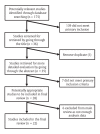Effect of Air Pollution and Hospital Admission: A Systematic Review
- PMID: 30779516
- PMCID: PMC6748301
- DOI: 10.9204/aogh.2376
Effect of Air Pollution and Hospital Admission: A Systematic Review
Abstract
IntroductionMany epidemiological studies have demonstrated associations between air pollution levels and human health in terms of hospital admissions. The aim of this paper is to gather evidence concerning air pollution effects on the risk of hospital admission. We hypothesised that increase in: particulate matter (PM), ozone (O3), carbon monoxide (CO), nitrogen dioxide (NO2), and sulphur dioxide (SO2) levels would be associated with the increasing trend of hospital admission.MethodsA systematic review of literature was carried out. Literature search was done in Sage, Ovid Medline, Science Direct, Wiley and ProQuest from 2010 to 2016 using keywords "hospital admission and air pollution". Studies of any relevant design were included if they presented original data, included at least one analysis where hospital admission was the specific outcome, and one or more of the following exposures were investigated: PM, O3, CO, NO2 and SO2.ResultsA total of 175 potential studies were identified by the search. Twenty two studies qualified for the review. Air pollution was noted to have an excessive risk of 3.46 (95%CI, 1.67, 5.27) of total hospital admissions. Cardiovascular admission was noted to have an increased risk of hospitalization for PM2.5 of 1.5 to 2.0; PM10 (1.007 to 2.7); NO2 (1.04 to 1.17) and SO2 (1.007). For respiratory admission, PM2.5 can caused an increased risk of hospitalization by 1.1 to 1.8; PM10 (1.007 to 1.13); NO2 (1.08 to 1.94) and SO2 (1.02). While O3 have minimal effect on COPD and stroke, CO does not influence in the effect of these hospitalization.ConclusionThe exposure to air pollutants confers an increased risk of admission of several disease. Our findings call for greater awareness of environmental protection and the implementation of effective measures to improve the quality of air, which may reduce the risks of adverse effects on the population's health.
© 2019 The Author(s). This is an open-access article distributed under the terms of the Creative Commons Attribution 4.0 International License (CC-BY 4.0), which permits unrestricted use, distribution, and reproduction in any medium, provided the original author and source are credited. See http://creativecommons.org/licenses/by/4.0/.
Conflict of interest statement
The authors have no competing interests to declare.
Figures
Similar articles
-
Effects of short-term exposure to air pollution on hospital admissions of young children for acute lower respiratory infections in Ho Chi Minh City, Vietnam.Res Rep Health Eff Inst. 2012 Jun;(169):5-72; discussion 73-83. Res Rep Health Eff Inst. 2012. PMID: 22849236
-
Association between exposure to ambient air pollution and hospital admission, incidence, and mortality of stroke: an updated systematic review and meta-analysis of more than 23 million participants.Environ Health Prev Med. 2021 Jan 26;26(1):15. doi: 10.1186/s12199-021-00937-1. Environ Health Prev Med. 2021. PMID: 33499804 Free PMC article.
-
[Meta-analysis of the Italian studies on short-term effects of air pollution].Epidemiol Prev. 2001 Mar-Apr;25(2 Suppl):1-71. Epidemiol Prev. 2001. PMID: 11515188 Italian.
-
Short-term exposure to air pollution and hospital admission for pneumonia: a systematic review and meta-analysis.Environ Health. 2021 Jan 7;20(1):6. doi: 10.1186/s12940-020-00687-7. Environ Health. 2021. PMID: 33413431 Free PMC article.
-
Association Between Ambient Air Pollution and Daily Hospital Admissions for Depression in 75 Chinese Cities.Am J Psychiatry. 2020 Aug 1;177(8):735-743. doi: 10.1176/appi.ajp.2020.19070748. Epub 2020 Apr 21. Am J Psychiatry. 2020. PMID: 32312109
Cited by
-
Hospital-borne hazardous air pollutants and air cleaning strategies amid the surge of SARS-CoV-2 new variants.Heliyon. 2024 Oct 5;10(20):e38874. doi: 10.1016/j.heliyon.2024.e38874. eCollection 2024 Oct 30. Heliyon. 2024. PMID: 39449698 Free PMC article. Review.
-
Combinations of Epidemiological and Experimental Studies in Air Pollution Research: A Narrative Review.Int J Environ Res Public Health. 2020 Jan 7;17(2):385. doi: 10.3390/ijerph17020385. Int J Environ Res Public Health. 2020. PMID: 31936042 Free PMC article.
-
Air quality and respiratory health in children.Breathe (Sheff). 2023 Jun;19(2):230040. doi: 10.1183/20734735.0040-2023. Epub 2023 Jun 13. Breathe (Sheff). 2023. PMID: 37377853 Free PMC article. Review.
-
The effect of air-pollution and weather exposure on mortality and hospital admission and implications for further research: A systematic scoping review.PLoS One. 2020 Oct 29;15(10):e0241415. doi: 10.1371/journal.pone.0241415. eCollection 2020. PLoS One. 2020. PMID: 33119678 Free PMC article.
-
Impact of exposure of particulate matters on stroke risk: exploring the influence of physical activity among middle-aged and older adults in China.Front Public Health. 2025 Jun 12;13:1595748. doi: 10.3389/fpubh.2025.1595748. eCollection 2025. Front Public Health. 2025. PMID: 40575094 Free PMC article.
References
-
- Committee HISO. Outdoor air pollution and health in the developing countries of Asia: A comprehensive review Special report 18; 2010. Health Effects Institute, Boston, MA.
-
- Amâncio CT and Nascimento LFC. Asthma and ambient pollutants: A time series study. Revista da Associação Médica Brasileira. 2012; 58(3): 302–307. - PubMed
-
- Bhaskaran K, Hajat S, Haines A, Herrett E, Wilkinson P and Smeeth L. The effects of air pollution on the incidence of myocardial infarction–A systematic review. Heart; 2009. - PubMed
Publication types
MeSH terms
LinkOut - more resources
Full Text Sources
Medical
Miscellaneous

